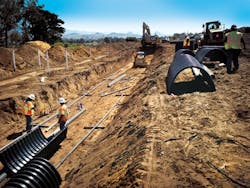One of the greatest pressures on a community is the ability to maintain its current infrastructure. Large decentralized wastewater treatment systems or community discharges are becoming common to solve infrastructure shortcomings, expand wastewater treatment plant capacity and provide sustainable development opportunities in areas not served by centralized treatment. These natural approaches sometimes take the form of a quasi-decentralized/centralized design and provide suitable long-term treatment solutions and return treated wastewater to groundwater supplies close to the point of origin, replenishing the aquifer.
When adequately designed and installed, a decentralized wastewater system has the capacity to accept large quantities of wastewater into the underlying soils, making it a passive, sustainable form of aquifer recharge. Decentralized systems can provide both wastewater treatment and groundwater recharge in one step or be designed with advanced-level treatment systems.
The utmost goal of wastewater treatment is the protection of public health. In some communities, sustaining development and growth while protecting the natural environment is another powerful mandate. Watersheds and groundwater supplies are critical areas under close scrutiny when in the proximity of any potential runoff or pollutant stream. Even municipalities themselves need to closely regulate not only the capacity and quality of their infrastructure systems, but also how any expansion or change to those systems could affect the surrounding area.
Extending the life of municipal wastewater treatment facilities and providing effective community-
wide wastewater treatment using infiltration chambers in municipal disposal field applications is a growing trend in decentralized treatment. Large businesses and communities no longer have to wait or pay exorbitant tap fees to tie into existing centralized services. Consultants can perform feasibility studies reviewing options for their clients, and the decentralized solution may yield the most beneficial cost position.
Large Decentralized or Small Centralized?
The melding of the two models has resulted in many asking if these are small centralized systems or large decentralized systems. Systems in the flow range of 10,000 gal per day to more than 1 million gal per day (mgd) have all of the components that a centralized system offers: collection, treatment, disposal, and an operations and maintenance (O&M) provider. In the case of a large decentralized system, the disposal is to a subsurface infiltration system. These large systems for large-flow commercial and industrial sites decrease the hydraulic and nutrient stress placed on centralized wastewater treatment plants. Centrally managed publicly and privately owned community systems are staffed with trained and educated O&M personnel in the same manner as centralized systems.
Large Community Case Study
The coastal community of Los Osos, Calif., previously met its wastewater needs with onsite wastewater treatment systems that had become outdated. As urban density increased, code-compliant systems could not be designed to fit the small lots. In addition, the coastal, agricultural community was experiencing saltwater intrusion as groundwater was pumped to meet demand; hence, saltwater began to intrude further inland. The Regional Water Quality Control Board declared a prohibition zone and building moratorium.
Originally, a new centralized wastewater treatment plant was proposed for Los Osos; however, initial exploration of this approach revealed that the discharge for a centralized wastewater treatment system would have to be an ocean outfall. This raised concerns that this outfall could exacerbate the saltwater intrusion due to the absence of the recharge that the current onsite systems were providing. Further feasibility studies of the ocean outfall option demonstrated that it would be cost-prohibitive. Ultimately, a decentralized solution that includes final discharge to a community drainfield, recharges groundwater supplies and minimizes saltwater intrusion was selected.
System Details
The completed large community treatment system, designed by CDM Smith, has a capacity of 1.6 mgd and includes collection, conveyance, treatment and recycled water reuse. The decision to select a community wastewater treatment system allowed Los Osos to meet its needs and regulatory challenges at a lower cost.
The system’s conventional gravity collection system includes pump stations, which deliver effluent to the wastewater treatment plant. The plant utilizes membrane treatment technology to remove nitrogen. The treated effluent then is pumped up a hillside, where the large subsurface disposal and recharge system is located under a 5-acre field that will remain open space. The disposal and recharge system utilizes approximately 20,000 ln ft of chambers installed in a series of trenches that offer enhanced infiltrative surface area to return the treated effluent to the soil to replenish groundwater supplies.
The treated effluent, pumped up to the recharge field system, is distributed through pressurized piping within the trenches. The system is divided into separate zones outfitted with controls and valves, which rotate the dosing evenly through each zone. The system also is equipped with monitoring ports to make it easy to observe water ponding heights. Other than occasional mowing and surface inspections, no additional maintenance is required. The final grade sheds surface water and the system is seeded and stabilized for erosion control.
Decentralized wastewater treatment can provide effective protection of public health and the environment. The recognition of this by engineers, environmental health officials and communities has propelled communities to use large-scale decentralized system designs to solve their challenges.
Download: Here


